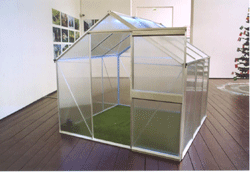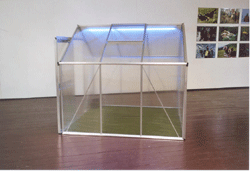greenhouse_bluebox
Making Nature, Augarten Contemporary, Belvedere, Vienna, 2002.

A part of the landscape gets lifted from its context and thus reinterpreted, transformed into a refuge, assigned to a museum, locked up, the inside and the outside celebrated in a manner akin to the Manichaen opposition between good and evil. Jean Paul Sartre said in a different context: "The death of God by no means leads back to the pagan cult of nature, but rather elicits a kind of atheistic Manichaeanism, in which the Gnostic difference between light and darkness is replaced by the opposition of nothingness and being."
Jean-Jacques Rousseau observed that the first person to have built a fence around his property was the founder of bourgeois society.
Within the fence a kind of anti-landscape arises, stocked with diverse arbitrarily thought-up characters from the arsenal of nature. A piece of land, that could just as well look like this or differently.
The garden, the greenhouse as anti-landscape, as land without qualities.
On the virtual level comparable to a "Blue Box", in which by means of the intense illumination something like a visualisation of coding systematics becomes possible, allowing the quite deliberate cultivation of the "Blue Box" greenhouse with literally countless possibilities. In contrast to nature, which acts unintentionally.
The procedural methodology of approaching the intersection between the decoding and recoding of landscape, the search for the paradox of this concept, together with its transformation, can be seen clearly in this example, which can been regarded as one of a series of projects in which I concern myself with the procedural transformation of landscape.
In the manner of the Japanese landscape gardens of the Muromachi era, where restraint was programmatic and suggestion was preferred to explicit statement, the greenhouse quite intentionally contains only a patch of lawn that is not even derived from the arsenal of nature. The lawn surface is a specially prepared artifical lawn, which certainly would not have needed the glass housing for the unfolding of its splendour. This lawn will never be stepped on, no one will ever roll on it. This apparently completely pointless production of a lawn draws attention, precisely because of its apparent pointlessness, to the actual, procedural nature of this project, establishing a direct link to the work lawnmower, a project about procedurality as a method in the investigation of grasses.
